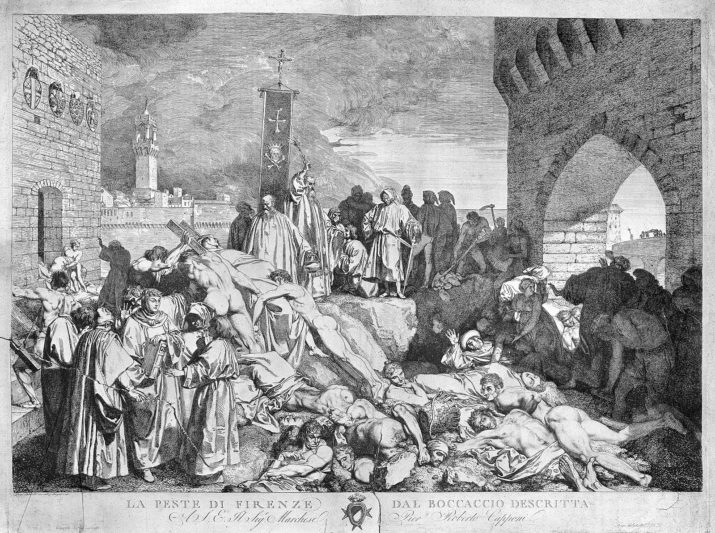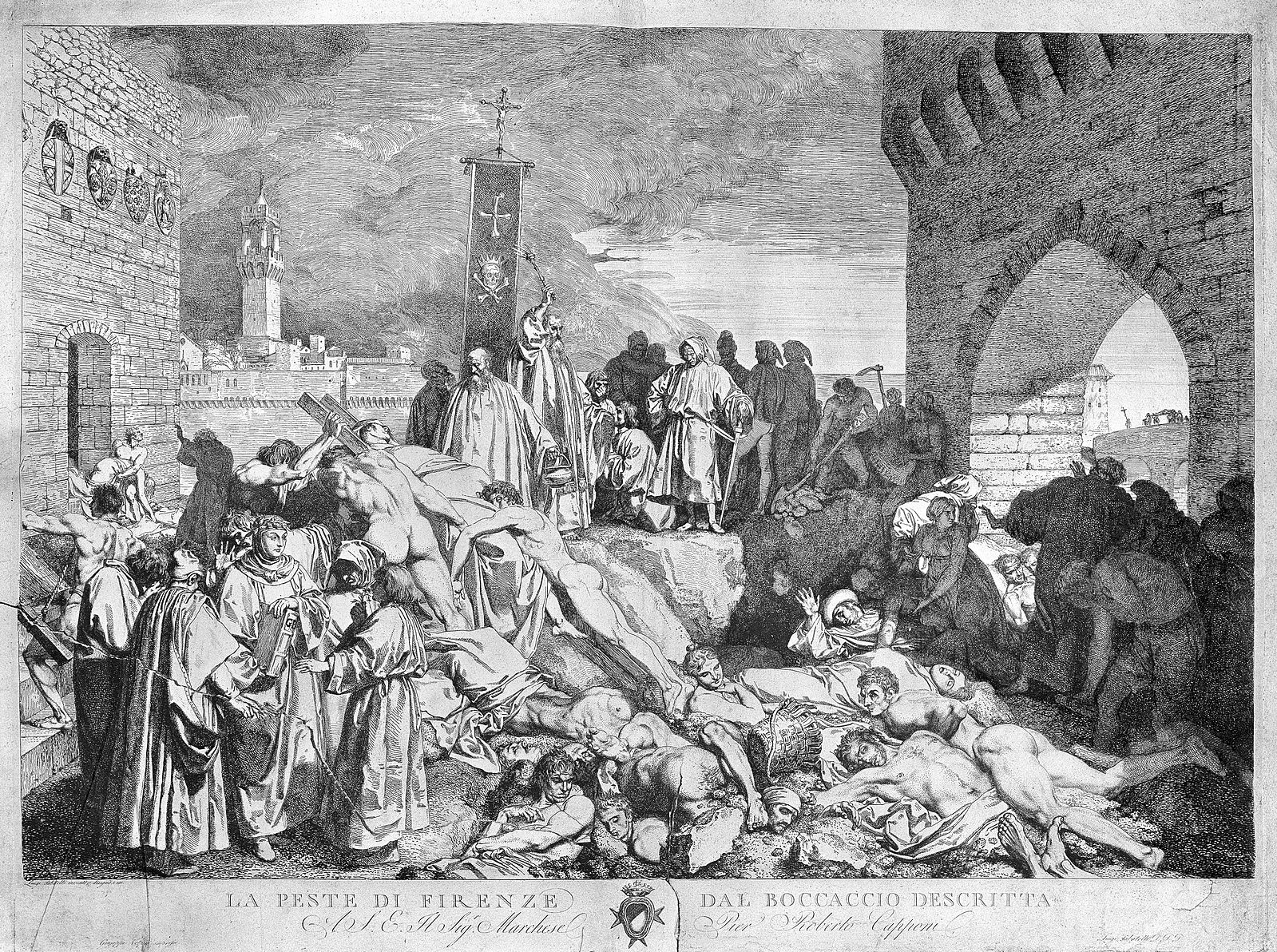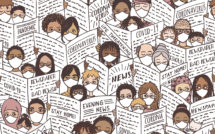

This is part of our Campus roundtable on Teaching Medieval in Modern Plague Times.
“It is a matter of humanity to show compassion for those who suffer,” opens Giovanni Boccaccio in the prologue to The Decameron. The prologue, and especially the first chapter of Boccaccio’s mid-fourteenth-century masterpiece, are well known to anyone who studies or teaches medieval history or literature. The Decameron begins with perhaps the most assigned and the most vivid description of Florence ravaged by the plague. This fall, as students begin or return to their university studies (many virtually), I imagine some will encounter the haunting description of a bustling Italian city devastated by the deadly disease. And as they read it, many will no doubt be struck by the similarities between the Florentines’ reaction to the plague and our current pandemic. Some secluded themselves, while others feasted. The citizens felt abandoned by secular and religious leaders, and the very fabric of society was strained by collective anxiety and grief. Of course, COVID-19, despite carrying off over a million people worldwide, pales in comparison with the Black Death, but the similarities in our reaction to it remain. As does Boccaccio’s exhortation to be compassionate.
Unlike many of my medievalist colleagues on university campuses across North America and beyond, my students did not read Boccaccio during the fall 2020 semester. In part, because I am not teaching classes on medieval Europe and, in part, because I have a strong suspicion many of my students will find themselves “pandemic’ed out,” tired and triggered by the endless barrage of breaking news reports, health advisories, and politicians’ speeches. Instead, my sections of the Roots of Contemporary Issues, an introductory world history class required for all students, will learn about the historical roots of other, no less urgent “plagues” of racism, labor exploitation, Islamophobia, and gender inequality. As a medievalist teaching on the main campus of a land-grant university in the Pacific Northwest, Washington State University, I must be versatile. Most of my students are not history majors and most likely will not take another history class during their time in college. From my perspective, this comes with an additional responsibility: I might be the only historian they will ever meet in person. In a year like 2020, when history is invoked nearly constantly by journalists and pundits grappling with health, civil rights, environmental, and political crises, it is my responsibility to teach them how professional historians work and think.
Fortunately, the Roots of Contemporary Issues is a course designed to teach students not only about the relevance of our global past but also about the very process of writing about it. At its core, is a semester-long individual research project. As long as their project deals with pre-1980 history and is set outside of the United States, students are free to pick any topic of interest to them. This year, the 1918 Flu is an understandably popular choice. But there is also a bumper crop of projects about the history of mental health care, incarceration, women’s rights, as well as the French, Haitian, and Russian revolutions. In general, since I began teaching this course in the fall of 2018, the share of topics related—in some form—to social justice and equity has only grown; perhaps a hopeful sign in our troubled times. After picking a topic, students are responsible for finding and perusing relevant primary and secondary sources. Then it is time to outline, practice forming a historical argument, and, finally, to write the paper itself. In the process, students learn to see research as a process—skills and knowledge take time and practice to master. Each assignment leading up to the final paper is designed to increase proficiency in writing and historical analysis gradually, allowing students with different educational backgrounds to learn together and succeed. The ability to experiment and take risks in a safe learning environment allows students to develop a “growth mindset” approach to learning, which helps alleviate performance anxiety with low-stakes workshops and assignments.
In addition to its research component, the Roots of Contemporary Issues is different from most world history classes in its approach to teaching about the past. Instead of overloading both students and faculty with the “tyranny of coverage”—the demand to include every major event, movement, and historical process within a certain period—the course is organized thematically. The themes, in turn, grow out organically from five broad categories: globalization, human interaction with the environment, interactions between diverse viewpoints, roots of inequality, and origins of contemporary conflicts. Individual faculty draw on their expertise and interests by providing a case study for each of the themes; students are explicitly taught to think of history as a way of gaining insights into present-day problems. In the process, students discover that the more novel and daunting an issue may seem, the more the analysis of its history can guide us towards a deeper understanding of it. This model for underscoring history’s utility can be applied to teaching history more broadly, especially in the interdisciplinary fields like European Studies, where a thematic approach can tease out longer patterns of continuity and change. One can easily imagine a similar approach to European history that uses modern challenges—globalization, right-wing nationalism, demographic changes, racial and social inequalities, the history of colonialism—to teach about Europe’s past as an explicit tool for responding to its present.
Between the research component and its global history subject matter, the Roots of Contemporary Issues classes have a lot of moving parts; success is not so much a matter of talent as of resilience and momentum. But this semester, in a year that will no doubt end up in history textbooks, student’s resilience is already stretched thin with every imaginable crisis, public and private. How does one teach in this environment, let alone help students succeed? It is uncharted territory, for me at the very least. I have taught online before but never as much, during a global health crisis, inside an election year, and against a background of white supremacist violence and budding authoritarianism. But like any well-worn cliché, the one about every crisis presenting an opportunity has some truth to it. The challenges of this unique semester made me consider how to add elements to my teaching that might make this class more welcoming and less stress-inducing for everyone involved. And as I survey between 30 and 50 Zoom squares in each of the three sections I teach, I can think of two key ideas that underpin my pedagogy in this unprecedented semester: compassion and connection.
Anyone who communicates with their students regularly these days knows the amount of stress they are under. Most still take the same course load as before, while having to study more, harder, and despite unreliable technology. Some share their families’ childcare responsibilities and other duties. Others are set back by a COVID-related decline of service industry jobs or must work longer hours. Students of color, first-generation students, students from underprivileged backgrounds, students with mental health issues, or with disabilities are all under additional layers of stress brought about by their circumstances. The faculty—a lot of us dealing with our own and very similar issues—cannot help with these problems, of course. Some days—many days—my own stress level is almost too much to handle. But I can lend an ear and show my compassion with both my words and actions. This semester I have been flexible with my deadlines and more willing than usual to accept late work. I have streamlined my assignment schedule and made most due dates fall on particular days of the week, a kind of weekly rhythm. I cut the cost of the textbooks by more than half. I try to check in with my students, listen and reassure them whenever I can. When they feel powerless, I urge them to vote and be active in their communities. My classes do not have any tests but if they did, I would eliminate them too (although I realize that is easier to do in a humanities class than in a STEM one). I made acknowledgments of student effort and encouragement part of my regular communications. In short, even small actions can make a difference. Importantly, none of these acts of compassion towards the students undermine the rigor or subject matter of the classes I teach. On the contrary: by showing flexibility and understanding, I created an environment in which students felt comfortable enough to produce good work.
In our times of social distancing and remote learning, it is equally upon us, as leaders and role models, to foster a sense of communal belonging. This is particularly important in online classes, where students rarely get to interact with each other beyond occasional discussion board assignments. This year, when most students do not even share a common experience of being in a classroom, it is particularly important to provide venues for students to be seen as more than a name on a roster. In my classes this fall, students were required to create a brief introduction using accessible (and free) platforms like Adobe Spark. These presentations allowed students to showcase themselves as individuals, with unique backgrounds, values, career goals, pets, partners, families, and dreams. They were then invited to watch and react to their peer’s presentations. In addition to practicing their presentation and communication skills, these assignments showcased my students as individuals, perhaps even more than any usual “icebreaker” activities in a regular face-to-face classroom. Near the semester’s end, students will create another round of presentations, this time about their semester-long historical research projects. Together, these relatively straightforward assignments give students a chance both to stand out and to learn about their classmates, to assert individuality, and to find things in common. For minority or underprivileged students, this is a particularly potent opportunity to offset “stereotype threat”—a fear of being perceived as just another student from a certain demographic. All in all, the presentations help students to feel more like a community, not an assemblage of Zoom squares. In a “flipped” virtual classroom like mine, where time is devoted almost completely to discussion and active learning, this helps everyone feel encouraged to participate.
2020 puts a unique premium on leadership. Absent in the White House, local governance and initiatives have helped states and cities weather the crises. The faculty are leaders, too, and our leadership can help citizens in and out of our classrooms. Will we police them with a digital iron fist (as the invasive surveillance through test-taking software becomes normalized on college campuses)? Or will we demonstrate understanding and compassion to our students? If we learn from history—especially from the global perspective—as we encourage our students to do, we can find plenty of evidence of empathy and humanity in the darkest of times. The past is scant on explicit lessons, but it can inspire us to be our best and most human toward each other. This semester, and for semesters to come, our students deserve nothing less.
Eugene Smelyansky is a Postdoctoral Teaching Fellow in the Roots of Contemporary Issues Program and the History Department at Washington State University. He is the author of Heresy and Citizenship: Persecution of Heresy in Late Medieval German Cities (Routledge, 2020) and a primary source collection, The Intolerant Middle Ages: A Reader (University of Toronto Press, 2020).
Photo: The plague of Florence in 1348, as described in Boccaccio’s Wellcome | Wikicommons
Published on December 8, 2020.




